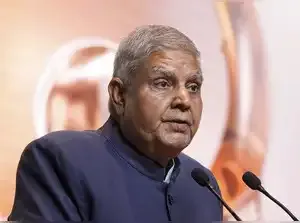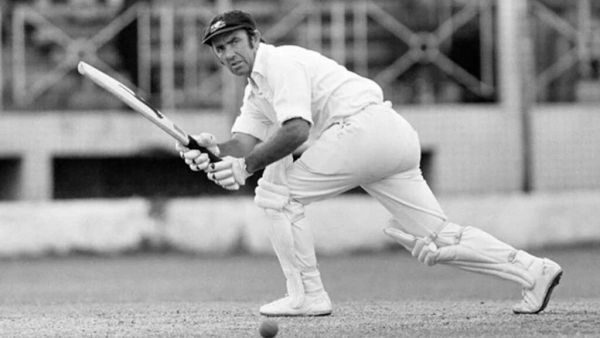Jagdeep Dhankhar, the 14th Vice President of India, resigned from office late on Monday. In a letter addressed to President Droupadi Murmu, he said, "To prioritise health care and abide by medical advice, I hereby resign as Vice President of India, effective immediately, in accordance with Article 67(a) of the Constitution."
The resignation came just hours after he presided over the opening day of the Monsoon Session of Parliament. Dhankhar also said he had received a letter concerning the impeachment of Justice Yashwant Varma, instructing the Rajya Sabha Secretary General to take further steps.
Aged 74, Dhankhar had assumed office in August 2022 and was expected to serve until 2027.
He further added, "Prime Minister's cooperation and support have been invaluable, and I have learned much during my time in office."
Also Read: Vice President Jagdeep Dhankhar resigns 'to prioritise health' as Monsoon Session kicks off
Now that the post lies vacant, the constitutional machinery to elect a successor must begin. Article 68(2) states that an election must be held "as soon as possible" following the occurrence of a vacancy.
The functioning of the Rajya Sabha remains unaffected by the resignation, owing to this established line of succession within the House.
Also Read: Who will become the next Vice President of India after Jagdeep Dhankhar's resignation?
The Vice President is elected by an electoral college comprising all members of both Houses of Parliament, including nominated members. Voting takes place via secret ballot, using the single transferable vote system to ensure proportional representation.
Once elected, the new Vice President will serve a full five-year term from the date they take office, not just the remainder of the previous term. This makes the role distinct from other constitutional positions where a successor may complete only the unexpired portion of a predecessor’s tenure.
Also Read: Why vice president Jagdeep Dhankhar resigned? Read his full resignation letter
In certain scenarios, the Vice President may also act as President of India if the sitting President is unable to perform duties due to resignation, death or removal.
The first was VV Giri, who stepped down in July 1969 to contest the presidential election after the sudden death of President Zakir Husain. The second was R Venkataraman, who resigned in July 1987 after being nominated for the presidency by the then ruling Congress party. He went on to serve as India’s eighth President.
The Vice President’s post, while largely ceremonial in some ways, holds strategic and constitutional significance. The coming days will see political parties weigh options carefully before deciding on a nominee with cross-party appeal.
(With inputs from TOI, PTI)
The resignation came just hours after he presided over the opening day of the Monsoon Session of Parliament. Dhankhar also said he had received a letter concerning the impeachment of Justice Yashwant Varma, instructing the Rajya Sabha Secretary General to take further steps.
Aged 74, Dhankhar had assumed office in August 2022 and was expected to serve until 2027.
Gratitude and farewell
In his letter, Dhankhar also acknowledged the working relationship he shared with senior leadership during his tenure. "I extend my deepest gratitude to Your Excellency - the Hon'ble President of India for her unwavering support and the soothing, wonderful working relationship we maintained during my tenure."He further added, "Prime Minister's cooperation and support have been invaluable, and I have learned much during my time in office."
Also Read: Vice President Jagdeep Dhankhar resigns 'to prioritise health' as Monsoon Session kicks off
What the Constitution says
The resignation of a Vice President is covered under Article 67 of the Indian Constitution. It allows the Vice President to step down at any time by submitting a written notice to the President. Once received and acknowledged, the resignation takes effect immediately. There is no formal approval process required.Now that the post lies vacant, the constitutional machinery to elect a successor must begin. Article 68(2) states that an election must be held "as soon as possible" following the occurrence of a vacancy.
Who takes charge until next VP is elected?
With the Vice President’s office now empty, the Deputy Chairman of the Rajya Sabha steps in to preside over proceedings in the Upper House. Harivansh, who has held the Deputy Chairman role since August 2022, will now take on these duties until a new Vice President is elected and assumes office.The functioning of the Rajya Sabha remains unaffected by the resignation, owing to this established line of succession within the House.
Also Read: Who will become the next Vice President of India after Jagdeep Dhankhar's resignation?
What is the election procedure for new VP?
The election to fill the vacancy will be conducted by the Election Commission of India, following rules laid out in the Vice-President (Election) Rules, 1997 and the Representation of the People Act.The Vice President is elected by an electoral college comprising all members of both Houses of Parliament, including nominated members. Voting takes place via secret ballot, using the single transferable vote system to ensure proportional representation.
Once elected, the new Vice President will serve a full five-year term from the date they take office, not just the remainder of the previous term. This makes the role distinct from other constitutional positions where a successor may complete only the unexpired portion of a predecessor’s tenure.
Also Read: Why vice president Jagdeep Dhankhar resigned? Read his full resignation letter
What is the eligibility criteria?
To contest the election, a candidate must meet a few clear conditions:- Must be a citizen of India
- Must be at least 35 years old
- Must be qualified for election to the Rajya Sabha
- Must not hold any office of profit under the Union or any state government
What are the roles and responsibilities of India's VP?
The Vice President of India holds the second-highest constitutional office after the President. One of the primary responsibilities is serving as the ex-officio Chairman of the Rajya Sabha. Although the Vice President does not hold membership in either House of Parliament, they are responsible for maintaining order and procedure in the Upper House.In certain scenarios, the Vice President may also act as President of India if the sitting President is unable to perform duties due to resignation, death or removal.
Only the third VP to resign mid-term
Dhankhar’s resignation places him in rare company. Only two other Vice Presidents have resigned mid-term in independent India’s history.The first was VV Giri, who stepped down in July 1969 to contest the presidential election after the sudden death of President Zakir Husain. The second was R Venkataraman, who resigned in July 1987 after being nominated for the presidency by the then ruling Congress party. He went on to serve as India’s eighth President.
What happens next
With Dhankhar stepping aside, the focus now shifts to the Election Commission, which is expected to announce a timeline for the election shortly. The process is expected to unfold swiftly, with 788 members of Parliament (543 from Lok Sabha and 245 from Rajya Sabha) forming the electoral college.The Vice President’s post, while largely ceremonial in some ways, holds strategic and constitutional significance. The coming days will see political parties weigh options carefully before deciding on a nominee with cross-party appeal.
(With inputs from TOI, PTI)








